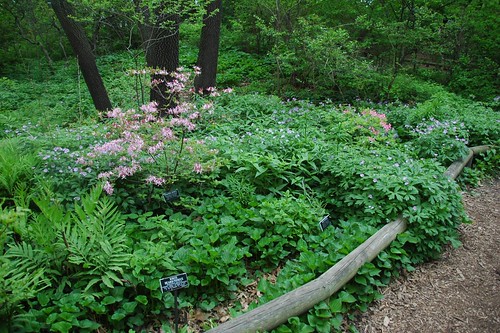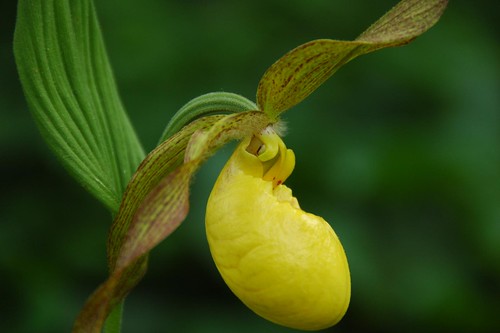The Native Flora Garden at the Brooklyn Botanic Garden, May 2009. This was the first garden constructed after BBG was established on the site of a municipal ash dump 100 years ago, and the first public garden devoted to native plants. Next Wednesday’s tour of this garden with Uli Lorimer, curator of BBG’s Native Flora Garden and an instructor in their Certificate in Horticulture program, is one of over 45 FREE events in all – available during NYC Wildflower Week.
NYC Wildflower Week kicks off Saturday 5/1. This is the third year for the event, and it’s bigger and better than ever. There are events all over the city, including tours of locations otherwise closed to the public. I’m looking forward to visiting, for the first time, the Greenbelt Native Plant Center on Staten Island, “the only municipal native plant nursery in the country.”
You can get all the details at the official, extensive, NYCWW Web site, or at the Parks Department event page:
From Friday, May 1, to Saturday, May 9, we’re celebrating the hundreds of native flowers, trees, shrubs and grasses in the Big Apple. Take advantage of the spring weather, and come out for a week of environmental learning, with free activities, walks, and talks galore.
I’m proud that this year, for the first time, I’ve been invited to participate in an official capacity. This Saturday morning, May 1, I’ll be on-hand at the information booth at Union Square to help answer questions and provide information about native plants.
A male Agapostemon, Green Metallic Bee, on a native perennial Helianthus, Sunflower, in my backyard native plant garden. Native plants provide vital habitat – food, forage, and shelter – for this and the rest of the more than 250 of bees native to NYC.
What can you do to help preserve NYC’s native plants?
Take a walk.
Head outdoors with a field guide and a friend to learn about the botanical jewels in your neck of the woods. Preservation comes to those places that are loved by people.Ride with the masses.
Whenever possible, take mass transit. Let your legislators know how you travel. New roadways promote sprawl and destroy and degrade habitat. If this money were instead used to bolster mass transit, we could conserve oil, preserve biodiversity and decrease sprawl.No picking.
Removing native plants from the wild depletes natural populations. Never take plants from parks or other open spaces. An exemption – if a site were slated for development, then the plants should be rescued and moved to another site, but ONLY if you were absolutely certain that the plants would otherwise be destroyed.Be civically active.
Development is the #1 cause of native plant destruction. Make note of open space slated for a strip mall or housing complex or active recreation area (because even settings like ball fields and golf courses eat up natural habitats). Attend community board meetings. Voice your dissent. Open space allows for passive recreation, like plant hunting, birding and hiking. Such activities nurture the naturalist in all of us.Preserve open space.
Work to save our natural areas. Become a member of a local land trust or conservancy devoted to preserving open space and natural resources. If one doesn’t exist, consider starting your own.Join a botanical society.
New York, New Jersey, Pennsylvania and Connecticut all have native plant societies. These groups lead tours through local fields and forests and always welcome new plant people. See our Resources page to learn more.Compost with care.
Most homeowners believe it is environmentally responsible to pile lawn refuse (grass clippings, leaves, twigs) in adjacent open areas. Don’t. By dumping garden waste in woods or at property edge, you may be inadvertently overwhelming critical habitat for plants and animals!Lay off the herbicide.
Is it really that important to have a “weed free” yard? The struggle for pristine green carpet (aka lawn) is a struggle against nature itself. Herbicides kill the native plants on and around your property. Instead, keep turf to a minimum, and maximize color, richness and beauty with native plant gardens.Legal protection for plants.
New Jersey, New York, Pennsylvania and Connecticut all have something in common – none of these states have laws safeguarding native flora. Moreover, they have no legal protections for rare plants. An undeveloped lot chuck-full of uncommon and unique vegetation is not legally viewed as special. This site is just as likely to be built upon as a lot full of crummy weeds. This happens even at the Federal level, where most of the money from the Endangered Species Act goes towards animal protection. Let your legislators know that your flora should have rights. Flower power!– Why Wildflowers?, NYC Wildflower Week
Cypripedium calceolus var. pubescens, BBG Native Flora Garden, May 2009
Related Content
Links
NYC Wildflower Week
Web site
Facebook Fan Page
Twitter stream
Other
Brooklyn Botanic Garden
Greenbelt Native Plant Center
Torrey Botanical Society
